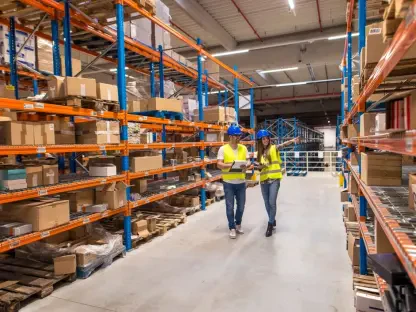The transformation of John F. Kennedy International Airport is set to redefine the landscape of air travel through a massive redevelopment plan worth $19 billion. This ambitious project not only marks a significant physical expansion but also showcases a groundbreaking reevaluation of airport operations aimed at improving efficiency, security, and overall passenger experience. At the heart of this transformation is The New Terminal One, designed to elevate JFK into one of the world’s top-tier airport hubs. Partnering with JCM Business Solutions, the project promises to streamline logistics, enhance security, and introduce sustainable practices that promise an unparalleled travel experience. This initiative sets a new benchmark for airport efficiency, ensuring JFK remains a principal gateway for the New York metropolitan area and beyond.
Innovative Logistics Approach: A New Era for JFK
Central to JFK’s reimagined future is an innovative approach to logistics that promises to enhance operational efficiency while minimizing impact on the environment. The New Terminal One has partnered with JCM Business Solutions to create a central logistics hub, the Consolidated Receiving and Distribution Center (CRDC). This 83,500-square-foot complex, situated adjacent to the airport, is designed to handle all logistics related to Terminal One. The approach aims to streamline delivery processes, minimize road congestion, and enhance security by centralizing and screening all incoming goods before they reach the terminal. By centralizing logistics, JFK aims to reduce the necessity for numerous third-party delivery trucks traversing airport roads, thus minimizing congestion and improving airport-wide coordination.
Moreover, the logistics hub is expected to generate around 60 new jobs, contributing positively to the local economy. This job creation is not just a boost for the workforce but also serves as a foundation for economic growth in the area, strengthening the airport’s community ties. The logistics hub’s strategic location and operations reflect a commitment to local economic advancement while preparing JFK for a seamless transition into a more streamlined future. By pioneering this centralized model, JFK positions itself as a forerunner in efficient airport operations, ensuring that the picture of a modern airport is one that efficiently balances the demands of traffic flow with robust security measures and community considerations.
Security and Efficiency: Key Enhancements
A significant focus of JFK’s transformation is the enhancement of its security architecture in tandem with operational efficiency. The logistics hub is a strategic move towards a more secure airport environment. All supplies earmarked for The New Terminal One will be channeled through the centralized logistics complex, where they will undergo meticulous screening based on rigorous standards set by both the Transportation Security Administration and the Port Authority. The logic behind this centralization is simple yet powerful: by reducing the number of vehicles required to make individual deliveries onto JFK’s premises, the risk factor associated with airside operations diminishes considerably, paving the path for a secure and smoothly running airport.
The elimination of myriad external deliveries not only bolsters security measures but also curtails the time and resources previously needed for cross-checking at various entry points. The process thereby boosts operational efficiency, allowing airport personnel to allocate more of their efforts to ensuring passenger safety and experience. The logistics hub effectively embodies a shift towards harmonizing security with efficiency, safeguarding JFK’s position as one of the world’s leading air travel hubs. This dual focus on security and efficiency fosters an environment where innovation and safety coexist, ensuring that JFK sets a global precedent for other airports aiming to modernize while maintaining rigorous security standards.
Technological Backbone: Driving Future Operations
The future of air travel at JFK leans heavily on the smart integration of advanced technology, which forms the backbone of its redeveloped operations. JCM Business Solutions has implemented cutting-edge cloud-based Warehouse and Transportation Management Systems (WMS and TMS) to optimize the logistics processes within the airport. These sophisticated systems are designed to offer higher predictability and productivity by facilitating real-time tracking and management of goods. The introduction of these technologies ensures that freight management becomes more intuitive, enabling personnel to anticipate and respond to changes in demand seamlessly.
These technologies are tailored to support JFK’s goals of creating a sustainable, seamless, and secure airport environment. They promote accountability and precision, reducing the margin for error and fostering an ecosystem where efficiency pervades every aspect of operations. By leveraging technology, JFK is setting new standards for passenger interaction, ensuring that visitors experience minimal delays and maximum service satisfaction. Furthermore, the adoption of these systems showcases JFK’s commitment to future-proofing its operations in an aviation landscape that is increasingly reliant on digital solutions to deliver superior service and operational excellence.
Construction and Economic Impact: Building the Future
The construction phases of the transformational project at JFK are as monumental as the operational changes they support. Scheduled to unfold across multiple phases, the initiative begins with the new arrivals and departures hall and the first 14 gates, which are expected to become operational by 2026. The project is anticipated to reach completion by 2030, culminating in a grand terminal expanse of 2.6 million square feet and housing 23 gates, making it the largest at JFK. This expansion promises not just to amplify JFK’s capacity but to solidify its stature as a premier international travel hub.
In tandem with the construction objectives, an economic boon accompanies the project, promising substantial opportunities for businesses and the workforce surrounding the airport. With global infrastructure giants like Ferrovial and JLC Infrastructure driving the initiative, the comprehensive development underscores New York’s commitment to advancing its facilities to cater to a growing influx of travelers. From industries indirectly tied to tourism, including hospitality and services, the ripple effect of such a monumental project is considerable, providing the impetus for sustained regional economic growth. Such extensive undertakings highlight the potential of urban infrastructure projects beyond immediate utility, serving as catalysts for broader economic and communal revitalization.
Community Commitment and Inclusivity: A Socially Responsible Model
A defining feature of JFK’s redevelopment is its unwavering commitment to community and inclusivity. The project is not only an infrastructural endeavor but also a pledge to deliver social value and equitable growth. A concerted effort is underway to utilize union labor throughout the construction and operations phases—a decision that emphasizes JFK’s dedication to fair wages and structured work environments. This focus on labor equity helps safeguard the interests of workers while contributing to a harmonious community synergy.
Moreover, ambitious inclusivity benchmarks have been set to ensure a diverse and representative workforce. The project endeavors to include 20% Minority-Owned Business Enterprises, 10% Women-Owned Enterprises, 10% Local Business Enterprises, and 3% Service-Disabled Veteran-Owned Businesses. Committing to these targets delivers tangible social outcomes, further ingraining the airport within the fabric of the community. The profound implications of these initiatives demonstrate a model where economic prosperity, diversity, and community integration occur in concert, establishing JFK’s redevelopment as a template for future infrastructure projects.
A Vision of a Futuristic Airport: Redefining Global Standards
At the heart of JFK’s vision for the future is a groundbreaking logistics strategy that seeks to improve operational efficiency while being kind to the environment. The New Terminal One has joined forces with JCM Business Solutions to establish the Consolidated Receiving and Distribution Center (CRDC), an 83,500-square-foot facility near the airport designed to manage all logistics for Terminal One. This centralized approach is intended to streamline delivery processes, alleviate road congestion, and boost security by consolidating the screening of all goods before they enter the terminal. By centralizing logistics, JFK aims to diminish the need for multiple third-party delivery trucks on airport roads, easing congestion and enhancing overall airport coordination.
Furthermore, the CRDC is poised to create approximately 60 new jobs, which will benefit the local economy. This job creation not only strengthens the workforce but also acts as a catalyst for economic growth in the region, deepening JFK’s connection with the local community. The strategic placement and functioning of the logistics hub highlight a commitment to local economic progress and efficiently poise JFK for a streamlined future. By leading with this centralized system, JFK sets a precedent in effective airport management, harmonizing traffic flow with heightened security and community engagement considerations.









